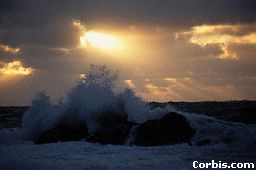"Local Knowledge - The Most Important Factor Of All!
Perhaps the most important factor in wave prediction is local knowledge of your surfing area. If you don't know where the breaks are, or haven't worked out the best conditions they work on, you can "wave predict" till you're blue in the face and still not get a wave. Local knowledge can be the most difficult aspect of wave prediction to learn and usually takes the longest. Once you have the local knowledge you will be able get waves under most swell and wind conditions, even if it's just to get wet. Some of the things that you need to get a grip on are;
· where the surfing spots are
· what are the best conditions for these to work on
· indicators of where to go
The first aspect is obvious. You need to know where to get waves. If you don't know this, then get out a map of your coastline and have a look.
The second aspect takes time, experience and patience to learn. Things that you need to know are the best tide, the best sized swell (and swell direction at some places), and the direction the wind has to be for offshore conditions (i.e. "what's offshore?") for breaks within your area. Other things that you may want to know for personal preferences is whether the break is a left or right-hander, what sort of break it is (i.e. reef, point etc.) and the wave characteristics (i.e. whether it's a gutless wave, or a full-on down the line hooter!).
The third aspect also takes time, experience and patience to learn. To understand the concept of using indicators, let's take some simple examples......

Example 1
You get down the coast to find that the waves where you usually surf are too small. However, down the road a bit you know the next beach cops more swell and you have a greater chance of getting bigger waves. What you've done is used your local knowledge and used your normal surfing beach as an indicator for potential better waves down the road.

Example 2
You may have worked out through experience that if a particular local beach (that is never surfed) has two foot waves, it means that the swell must be southerly and that a break you know of will be about 3-4 foot on the sets. What you've done to draw this conclusion (without even going to the break to check it) is you've used an indicator.
Indicators are important for wave prediction. If you don't know them for your area, or haven't worked them out yet, you will definitely miss out on good waves (believe me!). If you are new to place and have met and now surf with some of the locals, then you will pick up on important indicators quite quickly. If not, you will have to experiment. To do this, make a note of how big the surf is at your favorite surf break on a particular given day. Then go and check some other beaches or breaks (that may be closer to home) to see how they compare. Make a note of how they compare and remember it so that next time you can use them as indicators to predict how big, or even if it's worth checking your favorite spot."
Finale
"Hopefully you now know some of the finer points of wave prediction
and how complicated it can be. The majority of keen surfers have a good
understanding of the weather and their local surf spots, and can forecast
when and where the best waves will occur. To finish up, make a point of
monitoring the changing weather patterns and developing your local knowledge
of surfing spots and potential surf indicators where you live. If you stuff
up, don't despair: remember that it's all a learning process and that you
learn from your mistakes."
![]()